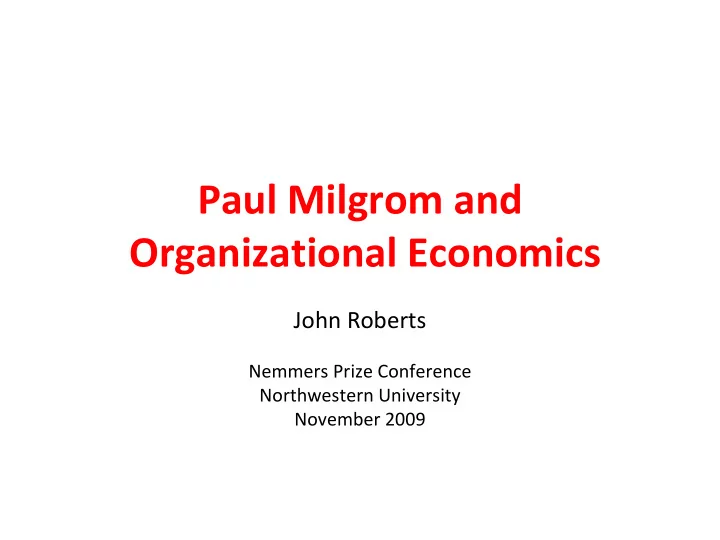

Paul Milgrom and Organizational Economics John Roberts Nemmers Prize Conference Northwestern University November 2009
Paul’s Partial Publication List • 1. Economics, Organization and Management (4018, 18pp) • 4. “The Economics of Modern Manufacturing: Technology, Strategy and Organization” (1571, 11pp) • 11. “Complementarities and Fit: Strategy, Structure and Organizational Change in Manufacturing” (903, 5pp)
Paul’s Partial Publication List • 20. “Employment Contracts, Influence Activities and Organizational Design” (454, 2pp) • 21. “Bargaining Costs, Influence Costs and the Organization of Economic Activity,” (442, 3pp) • 25. “An Economic Approach to Influence Activities in Organizations” (338, 3pp) • 29. “Organizational Prospects, Influence Costs and Ownership Changes” (279, 3pp)
Paul’s Partial Publication List • 35. “A Theory of Hierarchies Based on Limited Managerial Attention,” (155, 2) • 40. “Complementarities, Momentum and the Evolution of Modern Manufacturing,” (142, 1p) • 42. “Economic Theories of the Firm: Past, Present, Future” (111) • 46. “Communication and Inventories as Substitutes in Organizing Production” (86)
Don’t Forget • 2. “Multitask Principal ‐ Agent Analyses: Incentive Contracts, Asset Ownership and Job Design” • 10. “The Firm as an Incentive System” (I assume Bengt did these.)
Themes • Teaching Organizational Economics: 1 • (Incentive in Organizations) • Complementarity and Systems in OE: 4, 11, 40, 46 • Influence costs: 20, 21, 25, 29, 42 • Hierarchy: 35 • Economics of Management
Teaching Organizational Economics • EOM an intellectual and artistic success • A pedagogical failure if concerned with undergrads and MBAs as we intended • No one ever hired as an organizational economist, at least in a top ‐ ten department • Only MIT has as a field, few courses elsewhere • Few follow ‐ ups to EOM, no 2 nd edition • The hope of the Handbook of OE
Complementarity and Systems • “Economics of Modern Management” provided a set of assumptions sufficient to analyze organizations as multidimensional systems of interdependent parts – Not a lot more to do there in terms of tools – But failure to popularize the comparative statics techniques • AMR ’95 never finished • Not in the text books • Seen in the better journals – Milgrom ‐ Shannon
Complementarity and Systems • EMM (along with “Complementarities and Fit,” “Momentum” and “Communication and Inventories”) provided theoretical analyses of organizational changes in response to changing environmental variables (technology, prices) and of complementarities as defining patterns in design • Some more of these – e.g. Bagwell and Ramey, “Coordination Economies, Search Behavior and Advertising in Retail Markets,” AER 1994
Complementarity and Systems • Much more has been empirical (references) • Major impact on thinking about management, strategy, manufacturing, human resources, IT and organizational design
Influence Costs • Some models based on Influence costs, but not many. Mostly in economics and corporate finance. • Other papers cite but do not make a central part of the story. • Krugman’s embeddedness claim.
Influence Costs • Gibbons uses a version of Holmstrom (1982, 1999) to model influence costs. Equilibrium involves resources devoted to influence but no effect on decisions. • Put into a multi ‐ agent framework? • Or build a simple Tullock ‐ style model of rent ‐ seeking.
Influence Costs • A major element of our thinking around influence costs was how to mitigate them through organizational design • One tool was the allocation of decision rights and specification of decision criteria • This has become an active area of work, but influence costs have not driven the models.
Hierarchy • Two chapters in HOE – Garicano ‐ Van Zandt on team models – Mookherjee on incentives • Explanations are typically single ‐ variate – E.g. apply an associative operation efficiently – Learn relevant information – Contract on moral hazard • Managers do many things ‐‐‐ should we look to models with multitasking?
Economics of Management • Huge fraction of the work referencing Paul’s OE contributions appears in management journals ‐‐‐ general management, strategy, manufacturing and operations, HRM, finance • But economists generally ignore management in their models and their research – Exception: Lucas 1978 – Time to take management seriously
Recommend
More recommend